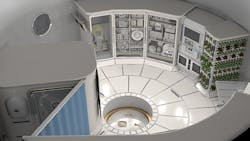NASA selects two new space tech research institutes for 'smart habitats'
The selected proposals create two multi-disciplinary, university-led research institutes to develop technologies critical to a sustainable human presence on the Moon and Mars. The smart habitat, or SmartHab, research will complement other NASA projects to help mature the mission architecture needed to meet challenging exploration goals.
“Partnering with universities lets us tap into new expertise, foster innovative ideas, as well as expand the research and development talent base for both aerospace and broader applications,” said Jim Reuter, acting associate administrator of NASA’s Space Technology Mission Directorate. “We’re excited to work with these two new STRIs to develop smart habitat technologies for exploration missions on the Moon and Mars.”
Related: Collins Aerospace to provide Earth-like atmosphere on Boeing’s new ‘space taxi’ for NASA
Each STRI will receive as much as $15 million over a five-year period. The selected institutes are:
Habitats Optimized for Missions of Exploration (HOME)
The HOME institute’s design approach for deep space habitats is one that relies not only on proven engineering and risk analysis, but also on emergent technologies to enable resilient, autonomous and self-maintained habitats for human explorers.
The institute seeks to advance early-stage technologies related to autonomous systems, human and automation teaming, data science, machine learning, robotic maintenance, onboard manufacturing, and more.
The HOME team is led by Stephen Robinson, principal investigator at the University of California, Davis, in partnership with the University of Colorado Boulder, Carnegie Mellon University, the Georgia Institute of Technology, Howard University, Texas A&M University and the University of Southern California. Industry collaborators include Sierra Nevada Corporation, Blue Origin and United Technology Aerospace Systems.
Resilient ExtraTerrestrial Habitats institute (RETHi)
RETHi seeks to design and operate resilient deep space habitats that can adapt, absorb and rapidly recover from expected and unexpected disruptions. The institute plans to leverage expertise in civil infrastructure with advanced technology fields such as modular and autonomous robotics and hybrid simulation.
Through an integrated effort, RETHi will mature deep space habitats that can operate in both crewed and uncrewed configurations. The institute plans to create a cyber-physical prototype testbed of physical and virtual models to develop, deploy and validate different capabilities.
The multidisciplinary team is led by Purdue University principal investigator Shirley Dyke, in partnership with University of Connecticut, Harvard University and the University of Texas at San Antonio.
Related: NASA chief says proposed budget is a 'huge vote of confidence' in the agency
The new selections will join two institutes founded by NASA in 2017. The established STRIs have advanced biological engineering and cutting-edge methods for developing carbon nanotube-based, ultra-strong and lightweight aerospace structural material.
The two inaugural institutes are the Center for the Utilization of Biological Engineering in Space (CUBES) and the Ultra-Strong Composites by Computational Design (US-COMP). Both of these undertakings are harnessing a talent base of inventiveness and innovation to help shape NASA’s pursuit of Earth-independent, self-sustaining exploration mission capabilities.
These selections are funded by NASA’s Space Technology Mission Directorate (STMD), which is responsible for developing the cross-cutting, pioneering, new technologies and capabilities needed by the agency to achieve its current and future missions.
For more information about STMD, please visit http://www.nasa.gov/spacetech.
Ready to make a purchase? Search the Intelligent Aerospace Buyer's Guide for companies, new products, press releases, and videos
